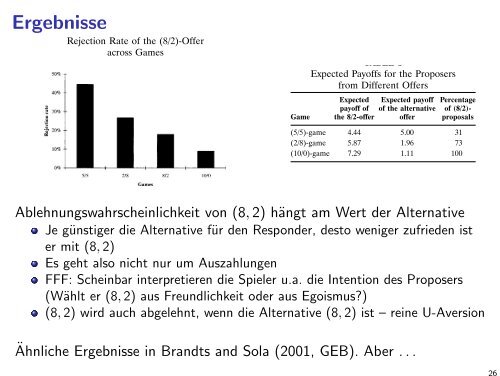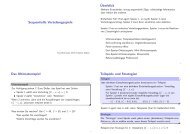Sequentielle Verteilungsspiele
Sequentielle Verteilungsspiele
Sequentielle Verteilungsspiele
Erfolgreiche ePaper selbst erstellen
Machen Sie aus Ihren PDF Publikationen ein blätterbares Flipbook mit unserer einzigartigen Google optimierten e-Paper Software.
24 ECONOMIC INQUIRY<br />
Ergebnisse FIGURE 2<br />
TABLE 1<br />
24<br />
Rejection Rate of the (8/2)-Offer<br />
across Games<br />
ECONOMIC INQUIRY<br />
Expected Payoffs for the Proposers<br />
from Different Offers<br />
FIGURE 2<br />
Expected ExpectedTABLE payoff Percentage 1<br />
Rejection Rate of the (8/2)-Offer<br />
payoff Expected of of thePayoffs alternative for of the(8/2)-<br />
Proposers<br />
across Games Game the 8/2-offer fromoffer Differentproposals<br />
Offers<br />
(5/5)-game 4.44 Expected 5.00 Expected31payoff Percentage<br />
(2/8)-game 5.87 payoff 1.96 of of the alternative 73 of (8/2)-<br />
(10/0)-game<br />
Game<br />
7.29<br />
the 8/2-offer<br />
1.11<br />
offer<br />
100<br />
proposals<br />
(5/5)-game 4.44 5.00 31<br />
(2/8)-game 5.87 1.96 73<br />
the rejection rate from 18% to roughly 45%<br />
(10/0)-game 7.29 1.11 100<br />
in the (5/5)-game suggests that intentionsdriven<br />
punishment behavior is a major factor.<br />
Thus, ithe seems rejection that reciprocity rate from 18% is actually to roughly 45%<br />
driven by both in the outcomes (5/5)-game and intentions. suggests that intentionsdriven<br />
we takepunishment a look at the behavior proposers’ is a major fac-<br />
Finally,<br />
(4 subjects) in the (10/0)-game. 7 The nonparametric<br />
Cochran Q-test confirms that the<br />
tor. Thus, the varying it seemsacceptance that reciprocity rate is actually<br />
behavior. Given<br />
of the (8/2)-offer<br />
differences in rejection rates across the four<br />
driven by theboth expected outcomes return andfrom<br />
intentions.<br />
Je günstiger die Alternative für denthis Responder, offer also<br />
games are significant (p < 0001). It also<br />
Finally, varied desto we across take weniger games. a lookTable zufrieden at the1<br />
proposers’ ist<br />
(4 subjects) in the (10/0)-game. 7 The shows non-thaparametric 2) the difference between the<br />
behavior. Given the varying acceptance rate<br />
it was least profitable to propose<br />
confirms er mit (8, that Cochran Q-test confirms that (8/2) the in the (5/5)-game and most profitable in<br />
(5/5)-game and the other three games is<br />
of the (8/2)-offer the expected return from<br />
differences in rejection rates across the the four (10/0)-game. The expected payoff of the<br />
statistically Es geht significant also nicht (p < nur 0001). umPair-wise<br />
Auszahlungen this offer also varied across games. Table 1<br />
games are significant (p < 0001). It alternative also offers exhibits the reverse order.<br />
comparisons that rejection rate<br />
shows that it was least profitable 8<br />
to propose<br />
FFF: Scheinbar confirms that interpretieren the difference die between Spieler Thisthe<br />
indicates u.a. that given the rejection behavior<br />
ofisthe responders, the payoff-maximizing<br />
in the (5/5)-game is significantly higher than<br />
(8/2)<br />
die<br />
in the<br />
Intention<br />
(5/5)-gamedes and most<br />
Proposers<br />
profitable in<br />
(5/5)-game and the other three games<br />
in (Wählt the (2/8)-game statistically<br />
er (8,(p 2) = significant<br />
aus 017, Freundlichkeit two-sided) (p < 0001). and Pair-wise<br />
oder aus the Egoismus?)<br />
(10/0)-game. The expected payoff of the<br />
choice is (5/5) in the (5/5)-game, (8/2) in the<br />
that the difference comparisons between confirm the that (2/8)- theand<br />
alternative offers exhibits the reverse order.<br />
rejection (2/8)-game, rate<br />
8<br />
and also (8/2) in the (10/0)-game.<br />
the (10/0)-game in the is(5/5)-game also highly is significantly (p =<br />
This indicates that given the rejection behavior<br />
of the responders, the payoff-maximizing<br />
higher The than last column in Table 1 shows that the<br />
017, two-sided). in the The (2/8)-game difference (p between = 017, two-sided) the<br />
vastand<br />
majority of the proposers made indeed<br />
(2/8)- and that the (8/2)-game the difference is, however, between only<br />
choice is (5/5) in the (5/5)-game, (8/2) in the<br />
the (2/8)- theand<br />
payoff-maximizing choice in each game.<br />
(weakly) significant if one is willing to apply<br />
(2/8)-game, and also (8/2) in the (10/0)-game.<br />
9<br />
the (10/0)-game is also highly significant Although (p = this proposer behavior is consistentthe<br />
with the assumption that the majority<br />
a one-sided017, test two-sided). (p = 068, The one-sided). difference The<br />
The last column in Table 1 shows that the<br />
between<br />
difference between the (8/2)- and the (10/0)-<br />
vast majority of the proposers made indeed<br />
Ablehnungswahrscheinlichkeit von (8, 2) hängt am Wert der Alternative<br />
(8, 2) wird auch abgelehnt, wenn die Alternative (8, 2) ist – reine U-Aversion<br />
Ähnliche Ergebnisse in Brandts and Sola (2001, GEB). Aber . . .




